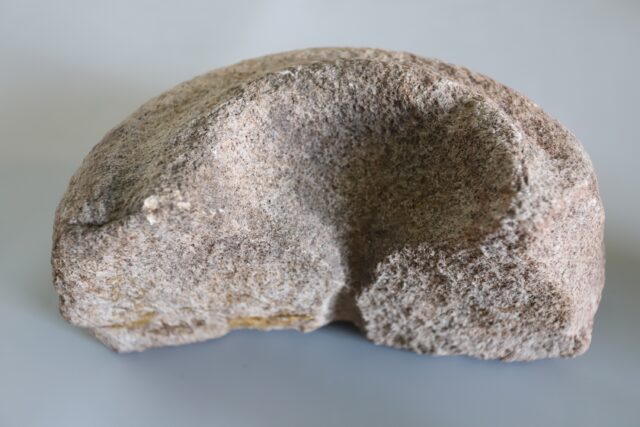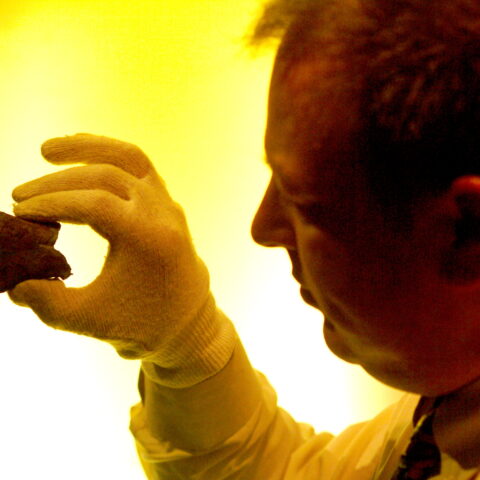MacDuagh’s Hermitage
St Colman MacDuagh was an early Christian cleric who lived in north Clare between c.560 and 632. He established a hermitage at the foot of Eagle Rock at Sliabh Carran, in the townland of Keelhilla, near Carran in Burren near the end of the 6th century. Today the site consists of:
- A stone oratory from about the 10th century.
- A holy well, known as St Colman’s well. Tradition tells us that it has a cure for eye problems. The well is fed by a spring.
- and a cave, located behind the stone oratory, called St Colman’s bed. According to tradition, the saint slept in the cave for the seven years that he was a hermit.
The site is quite isolated and remote even today. Its only visitors are hikers and the occasional tour group led by local guides. The site is maintained by the National Monuments Service. It was not a site the curator of the museum was familiar with in 2009.
The first report
In July that year a member of the public came to the museum to report the discovery of an archaeological object at the site. He reported that he had attended a guided tour of St MacDuagh’s Hermitage when a rotary quern-stone fragment was found near the holy well at the site. He said that the tour guide, Rory O’Shaughnessy, had noticed the quern-stone fragment. He speculated that it had become exposed by the action of spring water, flowing down a slight gradient from St Colman’s well, washing away the gravel and soil. It was left in situ, following a discussion between the tour guide and the group about its function. The visitor said that he returned to the site later to retrieve the quern- stone, but it had vanished. He was reporting it to the museum, and was wondering if it had been handed in, but it had not.
Having reported the broken disc-type rotary quern-stone, the visitor then mentioned that he had come across another interesting object. He described a stone that had been protruding from the ground and was an unusual shape. He said he removed it from the ground and left beside the walls of the stone oratory. From his description the curator formed the opinion that it could have been part of a beehive quern.
It would take a few days to arrange for the curator to locate and visit the hermitage. This time lag would turn out to be fortuitous.
Donation of the querns
A few days after this initial report, another person visited the museum in relation to the site. It was Rory O’Shaughnessy, the tour-guide the visitor had mentioned. Rory arrived at the museum, carrying the fragment of a rotary quern for deposit with the curator. This was possible because the curator is a designated person under the National Monuments (Amendment) Act 1994. This means the curator can claim archaeological objects for the state. Furthermore, as the museum is a designated building under the Cultural Institutions Act 1997, it is possible to keep this archaeological object in Clare. Without designation under these Acts, the fragment would have been sent to the National Museum of Ireland in Dublin.

Disc shaped rotary quern-stone fragment from MacDuagh’s Hermitage.
Rory O’Shaughnessy was kind enough to take the curator to the find site a few nights later. The visit allowed the curator to inspect the site and photograph the find place for a report to the National Museum of Ireland. Rory and the curator tried to locate the stone that may have been part of a beehive quern-stone. It was not located, and the matter the search was closed.
Then, a few months later, MacDuagh’s Hermitage came to the fore once again. In December, Christine Grant, an archaeologist with the National Monuments Service, came to the museum with a beehive quern fragment. Christine told the curator that it had been found at the hermitage the previous October. This must have been the stone the first visitor had found the previous July. It was a surface find, made during routine vegetation clearance by a Michael Killeen of Kilnaboy. Like the rotary quern, it was also claimed for the State under the Act.
Rotary querns: beehive type v disc type
The rotary quern is the best know quern-stone type. The first type was the saddle quern, developed by the first farmers during the Neolithic period. It was used along with a rubbing stone to grind grain to make flour. The flour was in turn used to make bread. This quern-stone type was replaced by the rotary quern during the Iron Age, the earliest form of which is the beehive quern. This type got its name because its beehive shaped top stone. The stone Rory brought to the museum was a disc-type rotary quern, a type that persisted in use in Ireland. The museum recently acquired a disc quern from near Kilrush with the date 1793 carved into it.
The rotary quern was a technological advance on the saddle type. The beehive rotary quern consisted of two thick circular stones of relatively small diameter. One was placed on top of the other, with the lower being stationary while the upper one was rotated. It was possible to turn the upper stone because of a side handle for which there would be a hole in the stone. Grain for grinding was fed into the quern via a central hole drilled through the upper stone. It was then ground between the faces of the two stones. The advantage over the saddle quern is that the weight of the upper stone helps break up the grain. Unlike the saddle quern, it did not need the downward pressure of the operator.
Beehive quern-stones are usually found north of a line from Dublin to Galway. This fragment came from near the Galway end of that line, but to the south, just outside the normal range. There appears to be only one other record of a beehive quern from Clare. It was found in the townland of Cohy near Kilfenora, about 10 km SW of the hermitage, as the crow flies. It was an upper stone, but decorated, and its find date is not known. Analysis of dates for beehive querns in the north of England, which is thought to be where beehive querns came to Ireland from, suggest a latest possible date for introduction to Ireland of 1st century AD.

Beehive quern fragment from MacDuagh’s Hermitage.
Our beehive quern-stone fragment represents about half of the top stone of the quern. It appears to be granite and it measures 25 cm x 12 cm. The hole was drilled from both sides. The diameter cannot be established but we can estimate it was about 3 cm. Its rough sides and smooth bottom suggest it was used for a long period of time. The hole for grain is wide at the top and narrower at the bottom. The beehive form was eventually replaced by disc form of rotary quern. According to Caulfield:
There is nothing to suggest that it [use of the beehive quern] survived beyond the middle of the first millennium AD and in fact could have gone out of use some centuries before then.
If we take it that St Colman founded his hermitage at the end of the 6th century and that it remained an active religious site until perhaps the 10th century, it likely that our beehive quern was used at least at the very end of the middle of the first millennium and possibly much later.
The surface of the disc quern fragment from MacDuagh’s Hermitage is quite rough and may be sandstone. As it is also broken in half, only half of the central hole of this quern is visible. The hole tapers inwards losing definition towards the base of the stone. It is 6 cam at its widest and 3 cm at its narrowest. The straight edge, where it has been broken in half, is 39 cm long. At one end the stone shows evidence of contact with fire. The rounded edge to the straight but broken edge is 20 cm at its widest. At its thickest, the broken edge is 9 cm. It appears to be the top stone of a disc quern.
It is interesting that the two quern-stones were top stones, both broken in half. Why they were broken, when and by whom we do not know. Today they are in storage at Clare Museum but can be viewed on the museum website.
References:
Anonymous, (undated blog), Eagle’s Rock, Slieve Carran – A Burren Walk – Visit the Burren, Burren Ecotourism [Accessed 14th April 2024]
Caulfield, Seamus, (1977), The Beehive Quern in Ireland, The Journal of the Royal Society of Antiquaries of Ireland, Vol 107, Royal Society of Antiquaries of Ireland
Caulfield, Seamus, (1977), A Decorated Beehive Quernstone from Co. Louth, Vol 19, No.1, County Louth Archaeological and Historical Society [Accessed 14th April, 2024]
Gibbons, E, MacDermott, J, Gibbons, F (1999), Catalogue of Archaeological Finds from County Clare From the Archives of the National Museum of Ireland, Vol. II, National Museum of Ireland.
Nugent, Louise, (2017), ‘St MacDuagh’s Hermitage, Co. Clare‘, pilgrimagemedievalIreland.com [Accessed 14th April, 2024]

